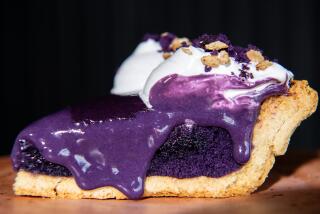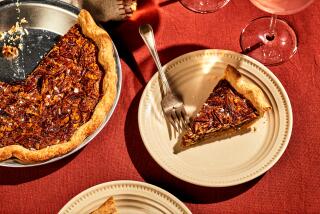Pie Crusts VI: Doubling Up
- Share via
To make a pie with an upper as well as a lower crust, prepare a recipe for double-crust pastry (See Back to Basics, Oct. 12) and divide the dough into two portions, one slightly larger than the other.
Roll out the larger portion and fit it into the pie plate. Trim the dough, leaving a 1/2-inch overhang. Roll the smaller portion of dough into a circle about an inch larger in diameter than the inverted pie plate.
Vents need to be cut in this top crust to let steam escape during baking and keep the upper crust from rising too high over the filling. A vented crust also comes out crisper.
You can use a sharp knife or decorative cutter to make the vents while the dough is lying flat after rolling. Another method is to fold the dough gently into quarters and then make the cuts (dust the surface of the dough lightly with flour before folding). The dough for the upper crust should be folded into quarters in any case before assembling the pie.
When the upper pastry is ready, pour the filling into the bottom crust. Working quickly, place the folded dough over one corner of the pie with the round vent at the center. Unfold the pastry over the filling and trim, leaving a one-inch overhang.
Tuck the top crust under the lower crust and press into an upright rim even with the edge of the pie plate. This high ridge, resting firmly on the rim, acts as a dam, holding the filling in the pie, and won’t fall into the pie during baking.
It’s important to work quickly once the filling is added so that the pie may be baked before the bottom crust has a chance to get soggy. Other ways to prevent a soggy bottom crust include brushing it lightly with egg white, melted butter or a light sprinkling of flour before the filling is added. Having the filling very hot also helps.


